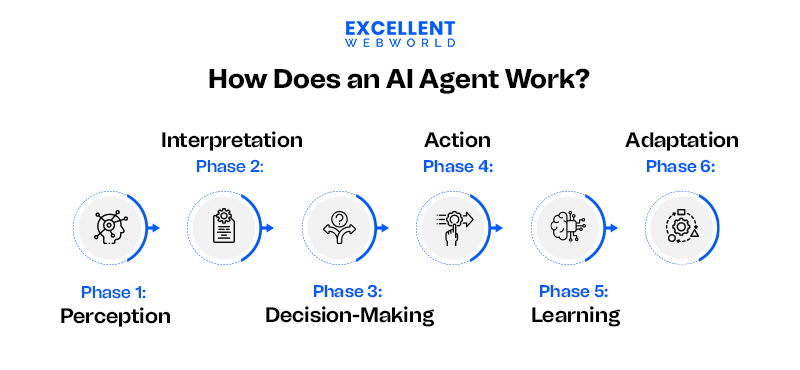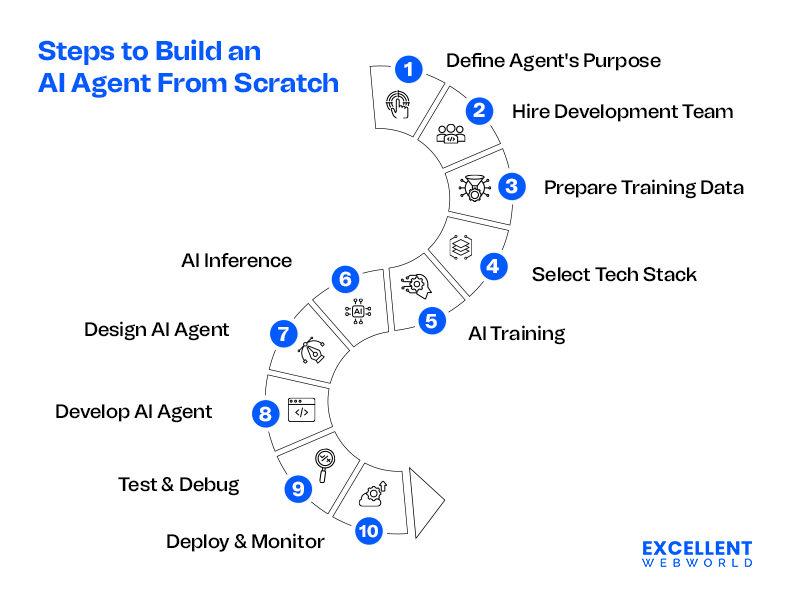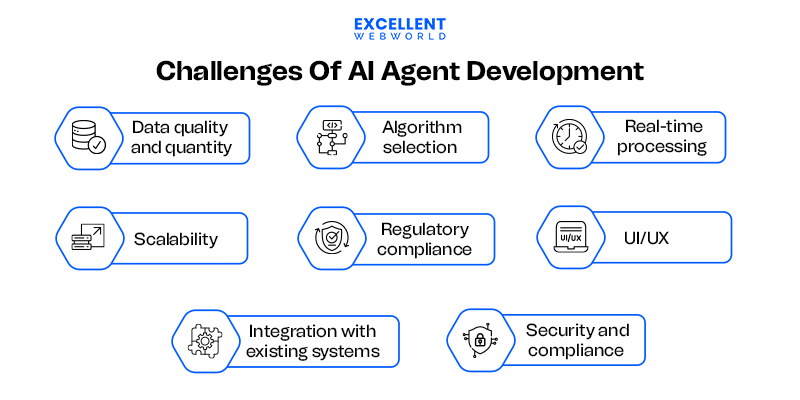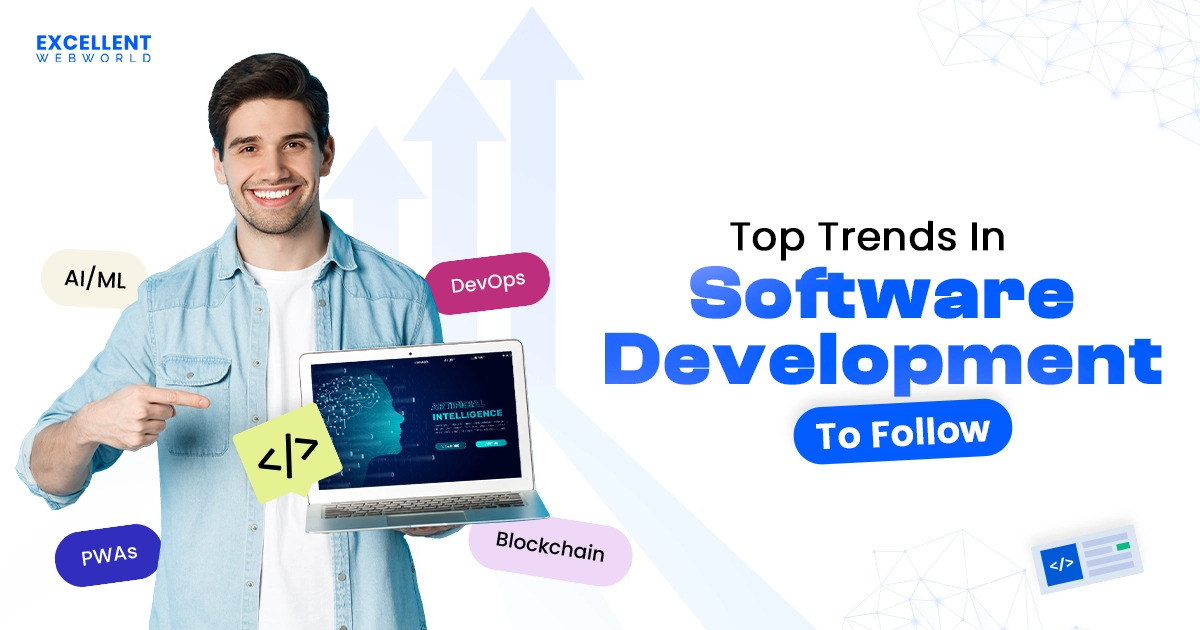Enterprises nowadays are using AI agents to handle work without human help. These smart computer programs can make decisions and solve problems on their own. They work like digital agents that never get tired and can do many tasks at once.
The change is happening now. In 2026, 99% of developers are actively building AI agents. At the same time, half of all companies worldwide are moving beyond experimentation into active AI integration in software, driving productivity, reducing costs, and delivering better outcomes.
How do you actually build and deploy AI agents that work in the real world? This is what every business leader wants to know. The answer isn’t complicated, but you need the right steps and tools to make it work.
The real question isn’t whether you should use AI agents. It’s about learning how to build and deploy AI agents correctly. This guide gives you a clear plan from start to finish. You’ll learn easy steps to build AI agents that fix real business problems.
Ready to dive in? You can read through this guide or, if you prefer to listen, just hit play on the podcast below and follow along!
What is an AI Agent? And How Does an AI Agent Work?
“An AI agent is a self-sustaining software entity designed to understand its surroundings, make choices, and take actions to achieve specific goals without human supervision.”
Learning how to build an AI agent starts with a clear understanding of what an AI agent is and how it functions. Unlike simply building an AI model, developing an AI agent involves creating a system that can perceives, thinks, and evolves through intelligent behavior. The following visual breaks down the six core phases of AI agent development.
Each phase requires thoughtful implementation to create systems that can effectively operate in complex domains.
Now that we apprehend what AI agents are and how they operate, it’s essential to realize that not all AI agents are identical. They are available in different types, each designed for a particular task and level of intelligence. Let’s find out more about them.
Types of AI Agents for Custom AI Agent Development
Understanding the unique types of artificial intelligence agents is crucial before you start developing AI agents. Each type has particular traits that make it suitable for specific applications and demanding situations.
| Type of AI Agents | Description | Pros | Cons | Best For | Real-Time Examples |
|---|---|---|---|---|---|
| Simple-reflex agents | Act based on current percepts only | Fast response, simple implementation | Cannot handle uncertainty or hidden states | Controlled environments | Thermostat, automatic doors |
| Model-based reflex agents | Maintain an internal model of the world | Can handle partially observable environments | More complex to implement | Dynamic environments | Self-driving car sensors |
| Goal-based agents | Work toward specific objectives | Solution-oriented, more flexible | Requires search algorithms, computationally intensive | Complex problem-solving | GPS navigation systems |
| Utility-based agents | Maximize “happiness” metrics | Optimize for best outcomes | Complex utility functions require balancing priorities | Decision-making under uncertainty | Recommendation system |
| Learning agents | Improve performance over time | Adaptable to new situations | Requires training data, can be unpredictable | Evolving environments | Virtual assistants, game AI |
By deciding on the proper agent type for your assignment, you will set up a solid basis for development. To help further, exploring some real-world examples of AI agents can clarify how different types are applied across use cases.
For businesses aiming to implement these agents, collaborating with an AI agent development company ensures the right architecture, workflows, and scalability are built into your solution from the start.
Steps to Build a Successful AI Agent
Creating an intelligent agent that could recognize, propose, and act autonomously calls for cautious planning and execution. Building an AI agent entails multiple disciplines, spanning data science, software engineering, and domain expertise.
Let’s explore the vital steps to create an AI agent and convert your AI idea into reality.
Step 1: Define the AI Agent’s Purpose and Scope
Every successful AI project begins with clarity of purpose. As the first of many steps to build an AI agent, ask yourself:
Define boundaries by determining what your agent should and shouldn’t do. Create user stories and scenarios to visualize how your agent will operate in real-world contexts. This foundational work prevents scope creep and ensures alignment between development efforts and AI business ideas.
Consider setting up key performance indicators (KPIs) so as to measure your agent’s success. These include accuracy metrics, response time, consumer satisfaction ratings, and business impact measurements.
Step 2: Hire the AI Agent Development Team
Assembling the right team is crucial for your agent’s success. An ideal AI development team typically includes the following:
Each role contributes particular expertise to the project. Hire a dedicated developer with experience in comparable projects, robust problem-solving abilities, and the capacity to collaborate efficiently.
Don’t want to get into the hassle of assembling the right crew? Then, hire AI developers from an enterprise-leading organization like ours, which has experience in providing world-class AI development services to complement your in-house crew.
Step 3: Gather, Clean, and Prepare Training Data for AI Agent Workflow
Your AI agent’s overall performance will be as excellent as the facts it learns from.
Begin data collection from:
Once collected, implement rigorous cleaning procedures to:
Finally, prepare your training data by:
Remember, this step often consumes most of the total project time but determines your agent’s ultimate capabilities.
Step 4: Select the Right AI Agent Tech Stack and Development Tools
Choosing a suitable technology stack is a strategic choice with long-term implications.
Consider these factors when selecting your tech stack:
Popular technologies for AI agent design include:
Your selection must align with both your on-the-spot desires and future growth plans.
Step 5: AI Agent Training and Model Selection for Intelligent Automation
This step forms the core of your agent’s intelligence.
Consider these AI training methodologies:
When selecting models, evaluate options based on the following:
Document your experiments methodically, tracking hyperparameters and results. Implement cross-validation to ensure robustness and keep models away from overfitting. This systematic approach will help identify the most suitable model architecture for your agent.
Step 6: AI Agent Inference and Model Deployment
Transitioning from training to production requires thoughtful implementation of inference capabilities.
Consider these things for AI inference capabilities:
Here are the model deployment strategies you should consider:
Properly implemented inference systems ensure your agent delivers value efficiently and reliably.
Step 7: Design Your Custom AI Agent Architecture
Designing an AI agent for your specific business needs requires thoughtful architectural planning.
Create a comprehensive design that includes the following:
Key architectural decisions include:
Your design should balance technical elegance with practical considerations like maintenance and future scalability, flexibility, and extensibility.
Step 8: Develop Your AI Agent Using Best Practices and Frameworks
Implementation transforms your designs into reality. Focus on:
Use software development best practices while developing your AI agent:
Consider developing a minimal viable product (MVP) early to validate core assumptions before full-scale AI agent implementation. Partnering with an experienced nearshore software development company can accelerate this validation process while maintaining cost efficiency.
Step 9: Test and Debug Your AI Agent for Optimal Performance
Rigorous testing ensures your agent performs as expected.
Implement these testing methodologies for your AI agent:
When debugging, use these tools and methodologies for AI systems:
Document all discovered issues and their resolutions to build institutional knowledge.
Step 10: Deploy and Monitor Your AI Agent
The process of AI agent deployment brings your agent to its users.
Consider these AI agent deployment options:
Implement comprehensive monitoring for your AI agent with the following:
Regular maintenance should encompass model retraining schedules, data refreshes, and machine updates to ensure continued relevance and overall performance.
After reading the above section, you must have got the answer to how to build an AI agent from scratch. However, understanding the AI agents development process goes beyond just the steps, you also need to overcome the obstacles that arise during implementation. Let’s explore that in the next section.
Challenges You May Face While Building and Deploying AI Agents
Building and deploying AI agents involves a complex set of technical, ethical, and organizational challenges. Unlike simpler AI models, autonomous agents must perceive their environment, make complex decisions, and execute multi-step tasks, which amplifies these difficulties.
Let’s discover these barriers and how to triumph over them.
1. Data Quality and Quantity in AI Agent Development
High-quality data is crucial for training powerful AI agents. You’ll face difficulties accumulating sufficient applicable information while making sure it’s clean, unbiased, and representative of actual-world scenarios that your agent will encounter.
Pro Tip: Start collecting and cleansing data early in your development method. Consider the use of data augmentation techniques to increase restricted datasets.
2. Algorithm Selection and Model Quality
Selecting suitable algorithms entails balancing accuracy, speed, and practical resource necessities. You’ll want to decide which machine learning procedures best match your unique use case while avoiding overfitting or underfitting problems.
Pro Tip: Begin with easier models and incrementally grow complexity as you apprehend your use case further. Test multiple algorithms to find the ultimate answer.
3. Real-Time Processing and Scalability
Your AI agent development platforms have to process information quickly to offer well-timed responses. Real-time abilities are complex when implementing complicated reasoning or dealing with considerable data volumes, mainly with constrained computational resources.
Pro Tip: Optimize your algorithms for velocity and think about implementing edge computing for time-bound operations.
4. Scalability of Enterprise AI Agents
As user needs grow, your AI system has to scale efficiently. You’ll face challenges keeping overall performance and response instances while handling extended loads without proportionally growing infrastructure expenses.
Pro Tip: Design your architecture with scalability in mind from the beginning, using modular components that can be extended further without much of a problem.
5. Ethical and Regulatory Compliance
AI development brings complicated moral issues, which include bias mitigation, equity, and transparency. You should navigate evolving regulations throughout distinct jurisdictions while ensuring your agent behaves accurately in all eventualities.
Pro Tip: Establish an ethics evaluation procedure and keep up to date on relevant policies in your target markets.
6. UI/UX Considerations in AI Agent Design
Creating intuitive interfaces that correctly speak your AI’s abilities and boundaries is tough. Users should understand how to interact with your agent while retaining appropriate expectations about its capabilities.
Pro Tip: Use usability testing tools and iterate based on feedback to refine your interface.
7. Integration of AI Agents with Existing Enterprise Systems
Incorporating artificial intelligence in app development requires compatibility with the present infrastructure. You’ll face technical hurdles ensuring seamless data flow between legacy systems and your AI elements without disrupting existing operations.
Pro Tip: Develop robust APIs and middleware solutions to facilitate easy data trade among your AI agent and existing infrastructure.
8. Security and Privacy in AI Agent Workflow
AI systems introduce unique security vulnerabilities, such as adversarial attacks, data poisoning, and privacy concerns. Protecting sensitive data whilst maintaining functionality presents ongoing challenges throughout your development lifecycle.
Pro Tip: Implement comprehensive security measures, together with data encryption, secure access controls, and everyday safety audits.
Understanding the challenges of building an AI agent helps in creating more effective answers. Now, let’s shift our attention to practical applications, exploring how AI agents are being used throughout unique industries to clear up troubles and drive meaningful impact.
Use Cases of AI Agents in Enterprise Automation
AI agents are revolutionizing how companies operate by automating complicated tasks and providing intelligent assistance across industries. Let’s explore the various applications where these digital assistants are making a significant impact, from enhancing purchasing experiences to improving healthcare services.
1. eCommerce AI Agents for Business Process Automation
These agents enhance purchasing experiences by providing personalised product recommendations, managing inventory, and dealing with order processing.
Amazon’s Rufus and Shopify’s Kit exemplify how AI agents reveal possibilities to streamline purchasing journeys.
2. Healthcare AI Agents for Intelligent Automation
AI is transforming healthcare with patient scheduling, medication reminders, and preliminary symptom analysis. Explore AI in healthcare statistics to understand its impact through data and industry trends.
Mayo Clinic’s symptom checker and Ada Health’s diagnostic assistant show how agents can provide preliminary guidance before the expert session.
3. Fintech AI Agents for Secure and Compliant Solutions
AI in finance can help in fraud detection, investment tips, and automatic customer service. Robo-advisors like Wealthfront and Betterment show the capability of automatic monetary consultation.
4. Customer Service AI Agents for Enhanced Workflow
These agents take care of routine inquiries, decreasing wait times and liberating human agents for complex problems. Understanding how to build an AI app for customer service can dramatically improve response time and satisfaction ratio, as is visible with HubSpot’s chatbots and Intercom’s Resolution Bot.
5. LLM-Based AI Agents for Advanced NLP and Decision-Making
Large language model agents like GPT-powered assistants excel at content generation, research, and complex reasoning tasks across domains. Examples include GitHub Copilot for coding and Jasper for marketing content creation.
6. AI Voice Agents for Real-Time Enterprise Applications
Voice-enabled assistants like Siri and Google Assistant demonstrate how natural language processing creates intuitive interfaces for users wanting to interact hands-free.
7. Role-Based AI Agents for Custom Business Needs
Specialized agents take on specific professional roles—from virtual tutors to IT support technicians—with expertise in defined domains. ELSA for language learning and IBM’s Watson Assistant for IT support showcase this specialization.
The Future of AI Agent Development and Enterprise Adoption
The horizon of the AI agent era shines with promise. We’re witnessing the sunrise of more incredible, intuitive, successful systems that analyze and adapt like never before. Soon, those virtual partners will seamlessly integrate into every facet of our lives.
Uh… Did I accidentally coin one of the most famous quotes in A.I.?
I would love to confirm this if it's true.
The quote is "A.I. won't replace humans, but humans using AI will replace humans who don't".
It's everywhere, and the origin of it seems to be this tweet. https://t.co/YSua8UdFBB
— Lucas Rizzotto (@_LucasRizzotto) April 15, 2024
This isn’t just clever wordplay – it’s a wake-up call. Your business needs a custom AI agent, not tomorrow, but today.
However, building something like this requires a partner who eats, sleeps, and breathes innovation. That’s where Excellent WebWorld steps in. We’ve helped countless businesses transform AI business ideas into reality, conducting rigorous testing to ensure flawless execution.
Our expertise spans industries, creating solutions tailored precisely to each client’s unique vision. So, why wait for the future when you can create it? Reach out to our AI innovators and craft an experience that will propel your business to the next level.
FAQs on Building and Deploying AI Agents From Scratch
AI agents act independently toward goals, making decisions without continuous human guidance. Regular AI solutions just respond to specific commands without genuine autonomy. Agents can adapt their behavior based on environmental feedback.

Article By
Paresh Sagar is the CEO of Excellent Webworld. He firmly believes in using technology to solve challenges. His dedication and attention to detail make him an expert in helping startups in different industries digitalize their businesses globally.






